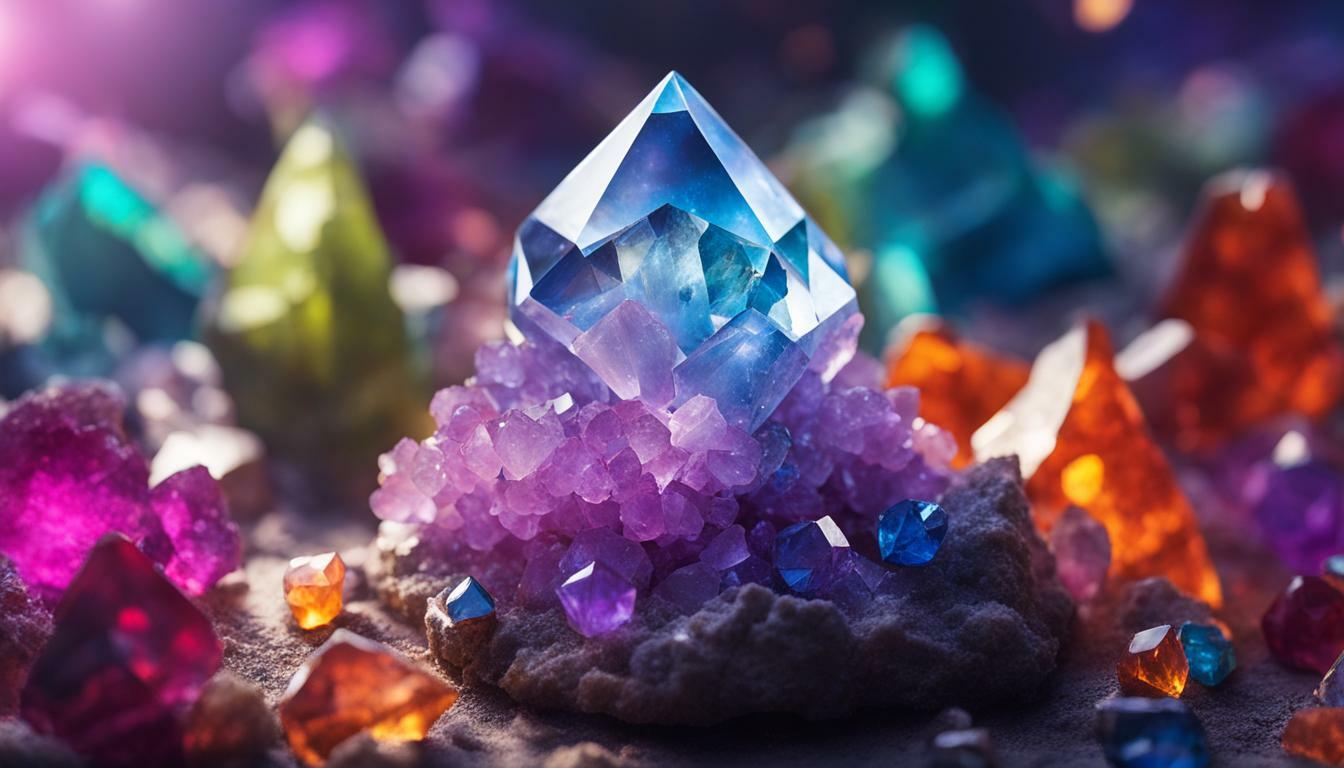Crystals can form in three primary ways, each resulting in distinct characteristics and formations. Understanding how crystals are created gives us a deeper appreciation for their beauty and uniqueness.
Key Takeaways:
- Crystals form through the process of crystallization, when liquids cool and harden.
- The evaporation of water from a mixture often leads to the formation of salt crystals.
- Existing crystals can undergo transformation through metamorphic processes, resulting in the formation of new crystals.
- Igneous rocks, sedimentary rocks, and meteorite impacts can contribute to crystal formation.
- The specific formation process determines the color, shape, and properties of crystals.
Crystallization Process: Cooling and Hardening Liquids
Crystallization is a fundamental process in crystal formation, occurring when liquids undergo cooling and hardening. This mesmerizing process is responsible for creating an array of stunning crystals, each with its unique shape, color, and properties.
When a liquid cools and reaches its saturation point, the molecules within it start to arrange themselves in repeating patterns, forming the foundation of a crystal lattice. As the cooling continues, the molecules align further, and the crystal begins to grow.
During this process, the rate of cooling and the composition of the liquid play crucial roles in determining the final crystal’s characteristics. For example, rapid cooling can result in small crystals, while slower cooling allows larger crystals to form. Additionally, the presence of impurities can influence the crystal’s color or even create intricate patterns within its structure.
Crystal Nucleation
Within the crystallization process, an essential step is crystal nucleation, where tiny particles, known as nuclei, act as starting points for crystal growth. These nuclei provide a template for the arrangement of molecules in the crystal lattice, facilitating the growth of larger crystals.
Crystal nucleation can occur spontaneously or with the assistance of external factors such as surfaces, temperature changes, or the presence of impurities. The precise conditions during nucleation can significantly impact the resulting crystal’s size, shape, and purity.
| Factors Affecting Crystal Formation | Impact on Crystal Characteristics |
|---|---|
| Rate of cooling | Determines crystal size |
| Composition of the liquid | Affects crystal color and properties |
| Presence of impurities | Creates patterns or alters crystal structure |
Understanding the crystallization process and its influencing factors allows us to appreciate the intricate beauty of crystals. The next time you gaze upon a crystal, remember the intricate journey it undertook, transforming from a cooling and hardening liquid into a mesmerizing structure formed by the forces of nature.
Evaporation: Formation of Salt Crystals
Evaporation is another way crystals form, particularly in the case of salt crystals, as water molecules escape from a mixture. When a saltwater solution is left undisturbed, the water slowly evaporates, leaving behind solid salt crystals. This process is commonly observed in nature, such as when seawater evaporates under the heat of the sun, forming beautiful crystalline structures along the shoreline.
The formation of salt crystals through evaporation is a fascinating phenomenon. As the water molecules evaporate, the concentration of salt in the solution increases. Eventually, the concentration reaches a point where the water can no longer hold all the salt particles in suspension. At this stage, the salt particles start coming together, binding to one another and forming crystals. The unique shape and structure of each salt crystal is determined by various factors, such as the specific type of salt present and the conditions under which evaporation occurs.
Table 1 below provides a comparison of the formation processes for salt crystals through evaporation versus cooling and hardening liquids:
| Formation Process | Crystals Formed | Key Factors |
|---|---|---|
| Evaporation | Salt crystals | Concentration of salt in solution, evaporation rate, temperature, and environmental conditions |
| Cooling and Hardening Liquids | Various types of crystals | Temperature, rate of cooling, chemical composition of the liquid, and presence of impurities |
It is important to note that the process of evaporation leading to salt crystal formation is not limited to seawater. It can also occur with other mixtures containing salt, such as brine solutions used in food preservation or saline solutions in laboratories. The formation of salt crystals through evaporation is not only a natural phenomenon but also a crucial process utilized in various industries, such as salt production, chemical manufacturing, and even the creation of art and decorations.
Metamorphic Processes: Transformation of Existing Crystals
Metamorphic processes can cause the transformation of existing crystals, leading to the formation of new and unique crystalline structures. When crystals are subjected to intense heat and pressure over time, their atomic arrangement changes, resulting in the creation of different crystals with altered properties. This process, known as metamorphism, plays a crucial role in the formation of various minerals and gemstones.
During metamorphism, existing crystals undergo recrystallization, where their internal structure is rearranged. This can occur due to tectonic forces, such as the collision of continents, or the effects of being buried deep within the Earth’s crust. As the crystals experience increased temperature and pressure, their atoms migrate, realign, and form new bonds, ultimately giving rise to distinct mineral compositions.
Metamorphic processes can create a wide range of crystals, each with its own unique characteristics. For example, the transformation of limestone under the influence of heat and pressure can result in the formation of the exquisite metamorphic rock called marble. This process not only changes the appearance of the limestone, but also enhances its strength and durability, making it a highly sought-after material in architecture and sculpture.
| Metamorphic Process | Resulting Crystal |
|---|---|
| Contact Metamorphism | Garnet |
| Regional Metamorphism | Quartzite |
| Dynamic Metamorphism | Mylonite |
Through the transformative power of metamorphic processes, crystals can evolve into entirely new forms, each possessing its own distinct beauty and properties. These new crystalline structures contribute to the diversity and wonder of the mineral world, captivating our imagination and reminding us of the incredible forces at work beneath the Earth’s surface.
Other Factors Contributing to Crystal Formation
Apart from the three main ways crystals form, other factors such as the presence of igneous rocks, sedimentary rocks, and meteorite impacts can also contribute to the creation of unique crystalline structures. These additional elements play a significant role in determining the color, shape, and properties of the crystals formed.
Igneous Rocks
Igneous rocks, which are formed from the solidification and cooling of molten rock, can interact with mineral-rich fluids to create crystals. As the magma cools, these fluids infiltrate spaces within the rock, allowing crystals to grow over time. The composition of the igneous rock and the minerals present in the fluids determine the type of crystals that form.
Sedimentary Rocks
Sedimentary rocks, on the other hand, are formed through the accumulation and compaction of organic materials, minerals, and other sedimentary particles. In some cases, these rocks can contain small pockets or voids that become filled with mineral-rich water. As the water evaporates, crystals start to form within these spaces, resulting in unique formations within the sedimentary rock.
Meteorite Impacts
The impact of a meteorite can cause extreme heat and pressure, leading to the formation of crystals within the surrounding rocks. These crystals can exhibit striking patterns and structures due to the intense energy released during the impact. Meteorite impacts have the potential to create rare and valuable crystals that are highly sought after by collectors and researchers alike.
Understanding the various factors that contribute to crystal formation allows us to appreciate the diverse range of crystals found in nature. From the cooling and hardening of liquids to the evaporation of water and the transformative power of metamorphic processes, crystals are a testament to the beauty and complexity of our natural world.
| Factor | Contribution to Crystal Formation |
|---|---|
| Igneous Rocks | Interaction with mineral-rich fluids can lead to crystal growth within the rock. |
| Sedimentary Rocks | Crystals can form within voids or pockets in sedimentary rocks as mineral-rich water evaporates. |
| Meteorite Impacts | Extreme heat and pressure from meteorite impacts can result in the formation of unique crystals within surrounding rocks. |
Conclusion
Understanding the three ways crystals form – through crystallization, evaporation, and metamorphic processes – provides a deeper appreciation for the beauty and complexity of these natural structures. Crystals are not just ordinary rocks; they are intricate formations that can captivate the human eye with their vibrant colors, unique shapes, and mystical properties.
The crystallization process, where liquids cool and harden, plays a significant role in crystal formation. As liquids solidify, their molecules arrange themselves into a structured lattice, giving birth to crystals. This process contributes to the creation of a wide variety of crystals, each possessing its own distinct characteristics.
Evaporation, on the other hand, leads to the formation of salt crystals. When water evaporates from a mixture, it leaves behind concentrated minerals that slowly crystallize over time. These salt crystals can be found in breathtakingly intricate formations, adding a touch of elegance to natural landscapes and creating fascinating patterns.
In addition to these processes, existing crystals can undergo metamorphic processes, resulting in the formation of new crystals. Under intense heat and pressure, crystals can transform, giving rise to entirely different structures. These transformations are responsible for the awe-inspiring diversity seen in mineral crystal formations.
It’s worth noting that crystals can also be influenced by external factors such as the presence of igneous rocks, sedimentary rocks, and even meteorite impacts. These influences shape the growth and development of crystals, further adding to their uniqueness.
By delving into the world of crystal formation, we gain a deeper understanding of the intricate mechanisms that govern the creation of these natural wonders. It is a testament to the awe-inspiring beauty and complexity of the Earth’s geological processes, reminding us of the marvels that exist right beneath our feet.
What Are Some Crystals That Represent Love?
Crystals representing love play a significant role in the metaphysical world. Rose quartz, known as the love stone, enhances self-love and healing in relationships. Rhodochrosite promotes unconditional love and compassion, while clear quartz helps to amplify loving energies. These crystals serve as powerful tools to attract and cultivate love in all aspects of life.
Can Different Types of Crystals Be Stored Together?
When it comes to crystals, storing them together may not always be the best idea. Each crystal has its own unique energy and properties, and when stored together, they can interact and influence each other. To ensure optimal care, it’s essential to follow a crystals stored together guide, which suggests storing like-minded crystals together and separating incompatible ones to maintain their individual energies intact.
What Crystals Resonate with Taurus?
When it comes to crystals for taurus, rose quartz is a popular choice. Known as the stone of love, it aligns well with Taurus’ nurturing and gentle nature. Green aventurine also suits Taurus, promoting abundance, luck, and fostering a sense of stability. Hematite is another crystal that resonates with Taurus, offering grounding energy and enhancing focus.
FAQ
What are the three ways crystals form?
Crystals can form through crystallization, evaporation, and metamorphic processes.
How does crystallization contribute to crystal formation?
Crystallization occurs when liquids cool and harden, leading to the formation of crystals.
How does evaporation result in the formation of salt crystals?
When water evaporates from a mixture, it can leave behind salt crystals as a result.
How do metamorphic processes transform existing crystals?
Metamorphic processes can cause existing crystals to undergo transformation, resulting in the formation of new crystals.
What other factors contribute to crystal formation?
Factors such as the presence of igneous rocks, sedimentary rocks, and meteorite impacts can also contribute to crystal formation.








